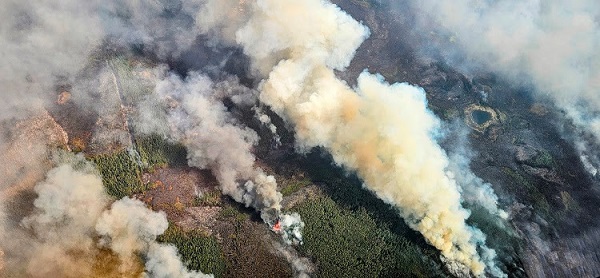Alberta
Preparation, swift response define wildfire season

Aerial view of wildfires near Fox Lake and Garden River in July.
Alberta concludes its 2024 wildfire season with renewed resilience, as vigilance and swift action helped keep communities safe and ready for the future.
Through effective investments, including a historic $155-million wildfire base budget, Alberta’s government ensured the province was prepared to respond throughout the 2024 wildfire season. In anticipation of the wildfire season, Alberta’s government recruited 100 additional wildland firefighters and an additional 40 contract wildland firefighters – in addition to securing more airtankers, heavy equipment, and helicopters equipped with night vision technology. As a result of this preparation, front-line crews were able to respond quickly and fight fires around the clock, containing 85 per cent of wildfires within 24 hours of detection.
“While the 2024 wildfire season was challenging, our coordinated efforts and the resilience of Albertans have been crucial in mitigating the impact. We will continue to adapt and strengthen our wildfire management strategies to protect our communities and natural resources.”
“This wildfire season has tested our resolve, especially in areas like Fox Lake and Jasper. The coordinated efforts of our firefighters and support teams were instrumental in protecting our communities. We will build on this experience to continue to improve response strategies and initiate new strategies to ensure the safety of all Albertans.”
The 2024 wildfire season began earlier than usual, with 64 carryover wildfires stemming from a mild winter and extremely dry conditions. In response to this elevated danger, Alberta’s government activated an early start to the wildfire season on February 20, 2024, implementing a fire ban and fire permit system to prevent additional human-caused wildfires.
Despite significant challenges, including large wildfires near Jasper that led to evacuations and the tragic loss of an Alberta wildland firefighter, as well as the loss of homes and businesses in the community, Alberta Wildfire demonstrated remarkable coordination, offering immediate aid and resources to Parks Canada, including support personnel, firefighters, aircraft and equipment.
While supporting the Jasper response led by Parks Canada, Alberta Wildfire crews continued to tackle substantial wildfires throughout the province, deploying personnel, aircraft and equipment to combat wildfires and assist impacted communities. Throughout the season, residents of Garden River, John D’Or Prairie, Fox Lake in the Little Red River Cree Nation, and the Chipewyan Cree Nation were also evacuated. Additionally, an area near Peace River and four neighborhoods in Fort McMurray faced short-term evacuations due to wildfires.
“In the wake of the heartbreaking loss from the Jasper wildfire, we are reminded of the strength found in collaboration – with each other and among all orders of government. We are reminded also of the compelling need to invest together in training, preparation, mitigation and adaptation, ensuring that we not only respond effectively, but that we also build a more resilient future.”
“The 2024 wildfire season underscored the importance of early planning and preparation. Investments in people, resources and new technology proved invaluable in our response efforts.”
During the 2024 wildfire season, Alberta Wildfire responded to more than 1,210 wildfires in the Forest Protection Area, exceeding last year’s record-breaking total. While the number of fires in 2024 exceeded the total number of fires in 2023, wildfires this season burned less than a third of the area compared with 2023, underscoring the effectiveness of Alberta’s preparation and investments.
Although Oct. 31 marks the end of Alberta’s wildfire season, Alberta Wildfire remains vigilant and ready to respond to any potential wildfires across the province.
Quick Facts
- Alberta Wildfire responded to more than 1,210 wildfires this year with more than 705,000 hectares burned.
- In 2023, there were 1,080 wildfires and more than 2.2 million hectares burned.
- Alberta Wildfire had almost 1,900 firefighters, contractors and support staff working on Alberta’s provincial response.
- Alberta Wildfire also received assistance from other agencies with more than 1,300 firefighters and support staff arriving from around the world to assist.
- While most wildfires were caused by people, we had 410 lightning-caused wildfires in July, the highest number in 20-years.
Related information
Alberta
Low oil prices could have big consequences for Alberta’s finances

From the Fraser Institute
By Tegan Hill
Amid the tariff war, the price of West Texas Intermediate oil—a common benchmark—recently dropped below US$60 per barrel. Given every $1 drop in oil prices is an estimated $750 million hit to provincial revenues, if oil prices remain low for long, there could be big implications for Alberta’s budget.
The Smith government already projects a $5.2 billion budget deficit in 2025/26 with continued deficits over the following two years. This year’s deficit is based on oil prices averaging US$68.00 per barrel. While the budget does include a $4 billion “contingency” for unforeseen events, given the economic and fiscal impact of Trump’s tariffs, it could quickly be eaten up.
Budget deficits come with costs for Albertans, who will already pay a projected $600 each in provincial government debt interest in 2025/26. That’s money that could have gone towards health care and education, or even tax relief.
Unfortunately, this is all part of the resource revenue rollercoaster that’s are all too familiar to Albertans.
Resource revenue (including oil and gas royalties) is inherently volatile. In the last 10 years alone, it has been as high as $25.2 billion in 2022/23 and as low as $2.8 billion in 2015/16. The provincial government typically enjoys budget surpluses—and increases government spending—when oil prices and resource revenue is relatively high, but is thrown into deficits when resource revenues inevitably fall.
Fortunately, the Smith government can mitigate this volatility.
The key is limiting the level of resource revenue included in the budget to a set stable amount. Any resource revenue above that stable amount is automatically saved in a rainy-day fund to be withdrawn to maintain that stable amount in the budget during years of relatively low resource revenue. The logic is simple: save during the good times so you can weather the storm during bad times.
Indeed, if the Smith government had created a rainy-day account in 2023, for example, it could have already built up a sizeable fund to help stabilize the budget when resource revenue declines. While the Smith government has deposited some money in the Heritage Fund in recent years, it has not created a dedicated rainy-day account or introduced a similar mechanism to help stabilize provincial finances.
Limiting the amount of resource revenue in the budget, particularly during times of relatively high resource revenue, also tempers demand for higher spending, which is only fiscally sustainable with permanently high resource revenues. In other words, if the government creates a rainy-day account, spending would become more closely align with stable ongoing levels of revenue.
And it’s not too late. To end the boom-bust cycle and finally help stabilize provincial finances, the Smith government should create a rainy-day account.
Alberta
Governments in Alberta should spur homebuilding amid population explosion

From the Fraser Institute
By Tegan Hill and Austin Thompson
In 2024, construction started on 47,827 housing units—the most since 48,336 units in 2007 when population growth was less than half of what it was in 2024.
Alberta has long been viewed as an oasis in Canada’s overheated housing market—a refuge for Canadians priced out of high-cost centres such as Vancouver and Toronto. But the oasis is starting to dry up. House prices and rents in the province have spiked by about one-third since the start of the pandemic. According to a recent Maru poll, more than 70 per cent of Calgarians and Edmontonians doubt they will ever be able to afford a home in their city. Which raises the question: how much longer can this go on?
Alberta’s housing affordability problem reflects a simple reality—not enough homes have been built to accommodate the province’s growing population. The result? More Albertans competing for the same homes and rental units, pushing prices higher.
Population growth has always been volatile in Alberta, but the recent surge, fuelled by record levels of immigration, is unprecedented. Alberta has set new population growth records every year since 2022, culminating in the largest-ever increase of 186,704 new residents in 2024—nearly 70 per cent more than the largest pre-pandemic increase in 2013.
Homebuilding has increased, but not enough to keep pace with the rise in population. In 2024, construction started on 47,827 housing units—the most since 48,336 units in 2007 when population growth was less than half of what it was in 2024.
Moreover, from 1972 to 2019, Alberta added 2.1 new residents (on average) for every housing unit started compared to 3.9 new residents for every housing unit started in 2024. Put differently, today nearly twice as many new residents are potentially competing for each new home compared to historical norms.
While Alberta attracts more Canadians from other provinces than any other province, federal immigration and residency policies drive Alberta’s population growth. So while the provincial government has little control over its population growth, provincial and municipal governments can affect the pace of homebuilding.
For example, recent provincial amendments to the city charters in Calgary and Edmonton have helped standardize building codes, which should minimize cost and complexity for builders who operate across different jurisdictions. Municipal zoning reforms in Calgary, Edmonton and Red Deer have made it easier to build higher-density housing, and Lethbridge and Medicine Hat may soon follow suit. These changes should make it easier and faster to build homes, helping Alberta maintain some of the least restrictive building rules and quickest approval timelines in Canada.
There is, however, room for improvement. Policymakers at both the provincial and municipal level should streamline rules for building, reduce regulatory uncertainty and development costs, and shorten timelines for permit approvals. Calgary, for instance, imposes fees on developers to fund a wide array of public infrastructure—including roads, sewers, libraries, even buses—while Edmonton currently only imposes fees to fund the construction of new firehalls.
It’s difficult to say how long Alberta’s housing affordability woes will endure, but the situation is unlikely to improve unless homebuilding increases, spurred by government policies that facilitate more development.
-

 2025 Federal Election9 hours ago
2025 Federal Election9 hours agoThe Federal Brief That Should Sink Carney
-

 2025 Federal Election11 hours ago
2025 Federal Election11 hours agoHow Canada’s Mainstream Media Lost the Public Trust
-

 2025 Federal Election14 hours ago
2025 Federal Election14 hours agoOttawa Confirms China interfering with 2025 federal election: Beijing Seeks to Block Joe Tay’s Election
-

 2025 Federal Election13 hours ago
2025 Federal Election13 hours agoReal Homes vs. Modular Shoeboxes: The Housing Battle Between Poilievre and Carney
-

 John Stossel10 hours ago
John Stossel10 hours agoClimate Change Myths Part 2: Wildfires, Drought, Rising Sea Level, and Coral Reefs
-

 COVID-1912 hours ago
COVID-1912 hours agoNearly Half of “COVID-19 Deaths” Were Not Due to COVID-19 – Scientific Reports Journal
-

 Entertainment2 days ago
Entertainment2 days agoPedro Pascal launches attack on J.K. Rowling over biological sex views
-

 2025 Federal Election1 day ago
2025 Federal Election1 day agoPoilievre Campaigning To Build A Canadian Economic Fortress


